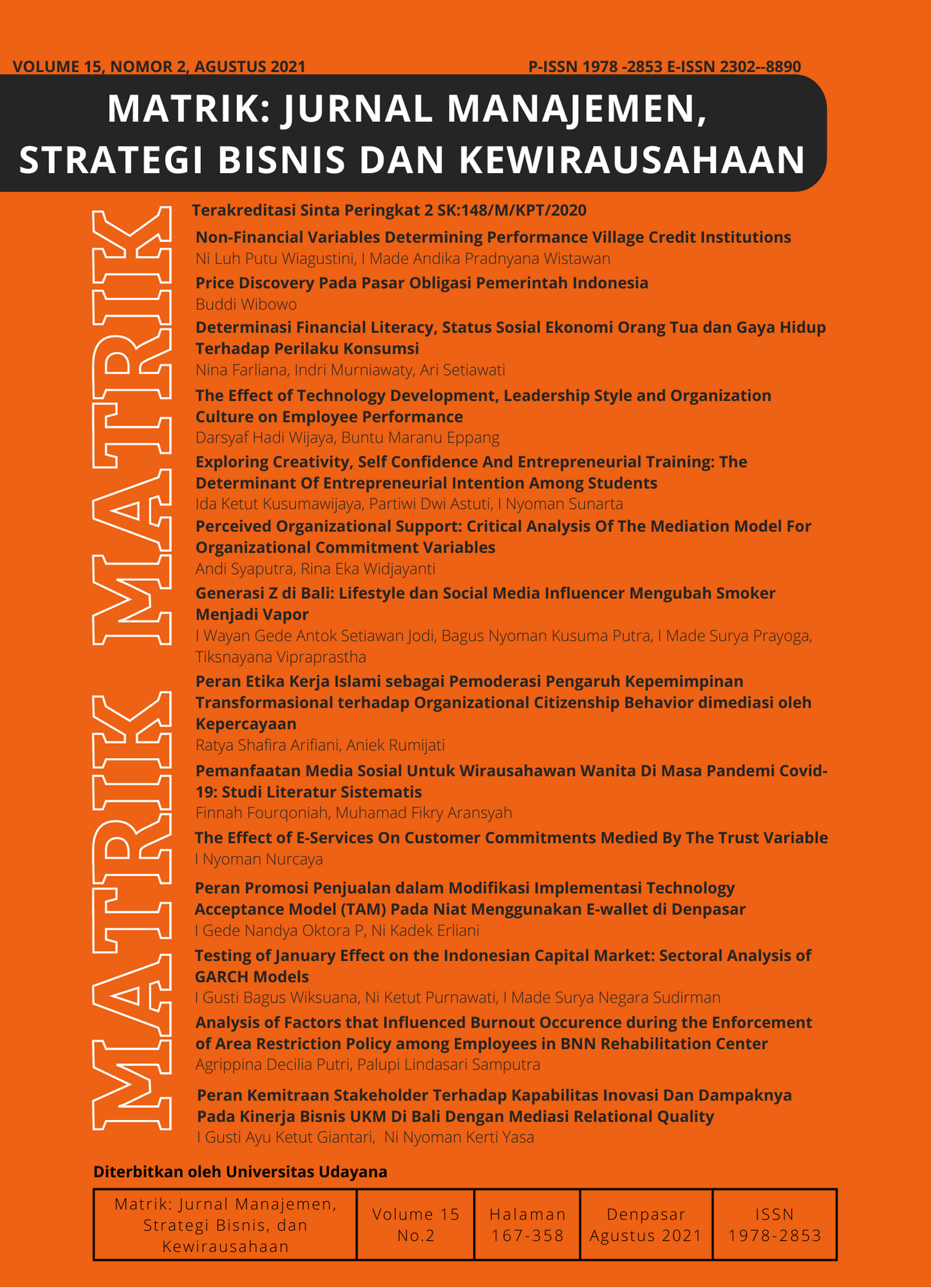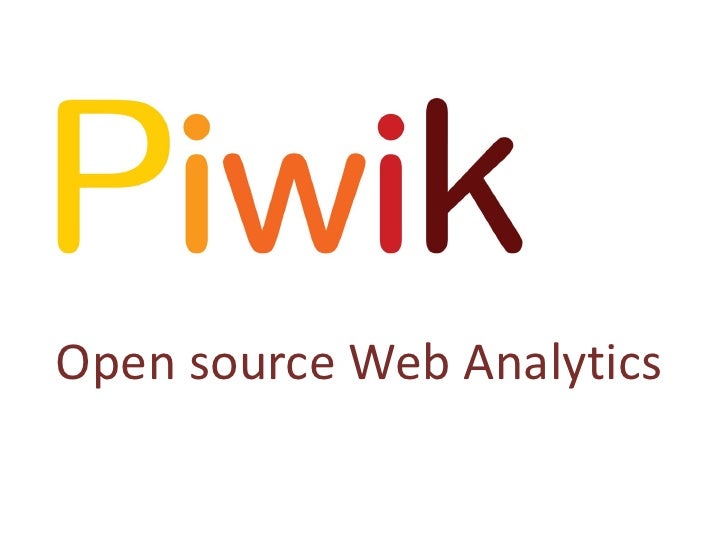Non-Financial Variables Determining Performance Village Credit Institutions
Abstract
The Village Credit Institution (LPD) as a rural microfinance institution, its operational activities are limited within the village area, experienced a fairly rapid development from eight units in 1984, reaching 1443 units in 2019, but there were 177 units (12.35 percent) not operating. The measurement of the performance of LPD is determined from the indicators of the level of health which are more assessed from financial ratios. In this study, non-financial variables were examined as variables that affect financial performance. This study aims to analyze the non-financial variables that determine the performance of LPD, which in this study are market orientation, entrepreneurial orientation, financial literacy, financial inclusion. The research population is LPD operating in Bali Province in 2019 as many as 1256 units. determined using the Slovin formula with an allowance of 10 percent, which is 93 units, Sampling with stratified proportional random sampling based on the health level of LPD, The method of analysis is Partial Least Square (PLS), it was found that the increase in entrepreneurial orientation, market orientation, financial literacy and the financial inclusion of the Village Credit Institution management has an impact on improving its performance. The implications for the management of the Village Credit Institution in improving its performance can increase entrepreneurial orientation, market orientation. financial literacy, management inclusion.
Downloads
References
Aragón-Sánchez, A., & Sánchez-Marín, G. (2005). Strategic orientation, management characteristics, and performance: A study of Spanish SMEs. Journal of Small Business Management, 43(3), 287–308. https://doi.org/10.1111/j.1540-627X.2005.00138.x
Atkinson, A., & Messy, F. A. (2011). Assessing financial literacy in 12 countries: An OECD/INFE international pilot exercise. Journal of Pension Economics and Finance, 10(4), 657–665. https://doi.org/10.1017/S1474747211000539
Bongomin, G. O. C., Mpeera Ntayi, J., Munene, J. C., & Akol Malinga, C. (2017). The relationship between access to finance and growth of SMEs in developing economies: Financial literacy as a moderator. Review of International Business and Strategy, 27(4), 520–538. https://doi.org/10.1108/RIBS-04-2017-0037
Buchdadi, A. D., Sholeha, A., Ahmad, G. N., & Mukson. (2020). the Influence of Financial Literacy on Smes Performance Through Access To Finance and Financial Risk Attitude As. Academy of Accounting and Financial Studies Journal, 24(5), 1–16.
Covin, J. G., & Slevin, D. P. (1991). A Conceptual Model of Entrepreneurship as Firm Behavior. Entrepreneurship Theory and Practice. https://doi.org/10.1177/104225879101600102
Dahmen, P., & Rodríguez, E. (2014). Financial Literacy and the Success of Small Businesses: An Observation from a Small Business Development Center. Numeracy, 7(1). https://doi.org/10.5038/1936-4660.7.1.3
Das, T. K., & Teng, B. S. (2000). A resource-based theory of strategic alliances. Journal of Management. https://doi.org/10.1177/014920630002600105
Haryanto, A. T., Haryono, T., Sri, H., & Sawitri, R. (2017). International Review of Management and Marketing Market Orientation, Learning Orientation and Small Medium Enterprises Performance:The Mediating Role of Innovation. International Review of Management and Marketing, 7(1), 484–491.
Idar, R., Yusoff, Y., & Mahmood, R. (2012). The Effect of Market Orientation as Mediator to Strategic Planning Practices and Performance Relationship: Evidence from Malaysian SMEs. Procedia Economics and Finance, 4, 68–75. https://doi.org/10.1016/s2212-5671(12)00322-x
Issaias, L. A., Odondo, A. J., & Okelo, S. (2021). Effect of Financial Inclusion on Performance of Microfinance Banks in Kenya. The International Journal of Business & Management, 9(2), 287–298. https://doi.org/10.24940/theijbm/2021/v9/i2/bm2102-036
Keh, H. T., Nguyen, T. T. M., & Ng, H. P. (2007). The effects of entrepreneurial orientation and marketing information on the performance of SMEs. Journal of Business Venturing. https://doi.org/10.1016/j.jbusvent.2006.05.003
Kimunduu, G., Erick, O., & Shisia, A. (2016). A study on the influence of financial literacy on financial performance of small and medium enterprises in Ruiru Town, Kiambu County, Kenya. International Journal of Economics, Commerce and Management United Kingdom, IV(11), 416–433.
Krisnia Putri, I. G. A. N., & Mustanda, I. K. (2019). Pengaruh Kecukupan Modal, Likuiditas, Dan Non Performing Loan Terhadap Profitabilitas Pada Lpd Di Kota Denpasar. E-Jurnal Manajemen Universitas Udayana, 8(6), 3360. https://doi.org/10.24843/ejmunud.2019.v08.i06.p03
Kumalasari, P. D., Putu, N., & Ernawatiningsih, L. (2014). The Determinants of Profitability in Village Credit. 11, 41–45.
Lee, S. M., & Peterson, S. J. (2000). Culture, entrepreneurial orientation, and global competitiveness. Journal of World Business. https://doi.org/10.1016/S1090-9516(00)00045-6
Lusardi, A. (2008). W13824.
Mutiso, A. N., & Muigai, R. G. (2018). An Assessment of Financial Literacy and the Performance of UWEZO Funded SME ’ s in Kirinyaga County , Kenya. Journal of Economics and Sustainable Development, 9(6), 10–17.
Ningsih, A. P., Luh, N., Wiagustini, N. L. P., Artini, S., Gede, L., & Rahyuda, H. (2015). Organizational Culture, Decision of Funding and Financial Performance: An Evidence from Small and Medium Enterprises. European Journal of Business and Management, 7(32), 148–158.
Nur, N., & Salim, U. (2014). Entrepreneurship Orientation, Market Orientation, Business Strategy, Management Capabilities On Business Performance; Study At Small And Medium Enterprise Printing In Kendari " International Journal of Business and Management Invention ISSN (Online, 3(12), 2319–8028.
OECD. (2015). G20/OECD Principles of Corporate Governance. In G20/OECD Principles of Corporate Governance. OECD Publishing. https://doi.org/10.1787/9789264257443-tr
Oranga, O. J., & Ondabu, I. T. (2018). Effect of Financial Inclusion on Financial Performance of Banks Listed At the Nairobi Securities Exchange in Kenya. International Journal of Scientific and Research Publications (IJSRP), 8(5), 624–649. https://doi.org/10.29322/ijsrp.8.5.2018.p7779
POJK Nomor 76/POJK.07/2016 tentang Peningkatan Literasi dan Inklusi Keuangan di Sektor Jasa Keuangan Bagi Konsumen dan/atau masyarakat, Pub. L. No. POJK Nomor 76/POJK.07/2016 (2016).
Riwayati, H. E., Salim, U., Maskie, G., & Indrawati, N. K. (2020). Financial Inclusion and Performance to Mediate the Effect of Banking and Tax Regulation on the Success of Small and Medium Enterprises in Indonesia. International Journal of Economics and Business Administration, VIII(Issue 3), 517–533. https://doi.org/10.35808/ijeba/541
Sanistasya, P. A., Raharjo, K., & Iqbal, M. (2019). The Effect of Financial Literacy and Financial Inclusion on Small Enterprises Performance in East Kalimantan. Jurnal Economia, 15(1), 48–59. https://doi.org/10.21831/economia.v15i1.23192
Sarma, M. (2010). Discussion Papers in Economics Index of Financial Inclusion. Centre for International Trade and Development School of International Studies. Jawaharlal Nehru University, 1–28.
Slater, S. F., & Narver, J. C. (2000). The Positive Effect of a Market Orientation on Business Profitability: A Balanced Replication. Journal of Business Research, 48(1), 69–73. https://doi.org/10.1016/S0148-2963(98)00077-0
Solikahan, E. Z., & Mohammad, A. (2019). Entrepreneurial Orientation, Market Solikahan, E. Z., & Mohammad, A. (2019). Entrepreneurial Orientation, Market Orientation and Financial Orientation in Supporting the Performance of Karawo SMEs in Gorontalo City. Journal of Applied Management (JAM), 17(. Journal of Applied Management (JAM), 17(4), 729–740.
Stanley, L. J., Hernández-Linares, R., López-Fernández, M. C., & Kellermanns, F. W. (2019). A Typology of Family Firms: An Investigation of Entrepreneurial Orientation and Performance. Family Business Review, 32(2), 174–194. https://doi.org/10.1177/0894486519838120
Sutika, I. K., & Sujana, I. K. (2013). Analisis Faktor Kinerja Yang Mempengaruhi Profitabilitas Pada Lembaga Perkreditan Desa. E-Jurnal Akuntansi, 5(1), 53–67.
Taheri, B., Bititci, U., Gannon, M. J., & Cordina, R. (2019). Investigating the influence of performance measurement on learning, entrepreneurial orientation and performance in turbulent markets. International Journal of Contemporary Hospitality Management. https://doi.org/10.1108/IJCHM-11-2017-0744
Taleghani, M., Gilaninia, S., & Talab, S. M. (2013). Relationship between Market Orientation Culture and Business Performance. Journal of Contemporary Research Business, 5(1), 949–954.
Theodosiou, M., Kehagias, J., & Katsikea, E. (2012). Strategic orientations, marketing capabilities and firm performance: An empirical investigation in the context of frontline managers in service organizations. Industrial Marketing Management, 41(7), 1058–1070. https://doi.org/10.1016/j.indmarman.2012.01.001
Umar, H. (2004). Metode Riset Ilmu Administrasi. PT Gramedia Pustaka Utama.
Wachira, M., & Kihiu, E. (2012). Impact of financial literacy on access to financial services in Kenya. International Journal of Business and Social ….
Wibisono, T., Universari, N., & Budiati, Y. (2020). Market Orientation, Entrepreneurship Orientation, and Company Performance: Study on Small and Medium Industries (Smes) Furniture in Demak District. Economics and Business Solutions Journal, 4(1), 20. https://doi.org/10.26623/ebsj.v4i1.2240
Wiklund, J. (1999). The Sustainability of the Entrepreneurial Orientation--Performance Relationship.(Statistical Data Included). Entrepreneurship: Theory and Practice.
 This work is licensed under a Creative Commons Attribution-ShareAlike 4.0 International License.
This work is licensed under a Creative Commons Attribution-ShareAlike 4.0 International License.

















